[ Español ]
This section contains schematics to build useful video cables to interconnect various types of displays and devices. Cables VGA to Scart, VGA to Arcade monitor and VGA to composite video in black and white require the PC video card to output compatible TV and Arcade monitor refresh rates at 15,6 kHz 50/60 Hz. PC video cards do not include these configurations by default but some models can be set with one of the following tools:
This cable lets you connect a TV set with a RGB capable scart input to the PC VGA output. It is necessary to set the PC video card to output a 15.6kHz 50/60 Hz signal so that line and frame refresh frequencies are TV/Arcade monitor compatible as explained in the Introduction.
To determine if your TV set scart socket is RGB capable you can use a DVD player or DTV decoder, connect it to the scart socket and switch between composite video (CVBS) and RGB modes from the player configuration menus. Look for subtle differences in picture sharpness or colours (maybe you must save or exit the configuration menu for the change to take effect), if you can see these changes then the socket supports RGB. Note: to conclude it supports RGB it is not sufficient to get a picture in RGB mode but you must notice a subtle difference in picture quality switching between CVBS and RGB.
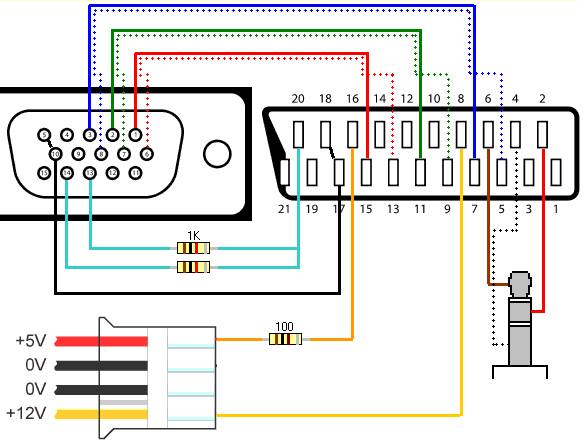
To avoid noise in the picture or audio it is strongly recommended to use shielded cable for RGB and audio signals, shields are drawn in this schematic with dotted lines. To get the best sharpness use 75 ohm video cable.
The connector at the bottom right is a stereo male audio jack to plug to the PC sound card. It brings PC sounds to your TV speakers.
Note: if you use a standard male-male scart cable and a female socket you must change the following pins: 20 → 19, 6 → 3 and 2 → 1. This is because a male-male cable connects inputs to outputs.
Connection to a MOLEX PC power plug is required for proper operation unless your TV set allows manual switching to RGB. It is not enough to be able to switch to scart input, it must allow switching to RGB mode. Only few sets allow this so I strongly suggest to add these connections so that switching will be automatic.
There are some alternatives to the MOLEX plug to get the necessary power. All of them only provide 5V so for the 12V cable you can leave it out (you will have to switch your TV manually to its scart input) or connect it to 5V (some TVs will not switch while others will activate wide screen mode (16:9), it is fine for wide screen sets but not for normal (4:3) sets where there may be a button or option to disable wide screen mode).
With these alternatives you can build a more portable cable and avoid the need to enter a cable inside your PC.
Scart and VGA standards specify a set of electrical characteristics (voltages and currents allowed) for all signals in these ports. All devices are designed according to these standards and operation outside them may cause damage or wrong operation.
Specifications of synchronization signals for Scart and VGA differ significantly, so they are incompatible and cannot be connected. There are important differences: scart composite sync expects a 0.3 V sync signal and has a low input impedance of 75 ohm while VGA outputs 5V TTL separate sync signals and expects high impedance loading.
Given these specifications there is fortunately a very simple solution consisting of two resistors that:
Resistors are really cheap and in my opinion it is not worth the savings. Without these resistors both devices may be damaged: the TV set that receives a signal 10 times stronger and the video card that sees an overload in its sync outputs.
When H and V signals are short circuited together one signal could take over the other and cause unstable display. Some TV sets measure sync signal strength to adjust picture contrast (this is to compensate signal drops in cables and connectors) and with a signal 10 times stronger you will get a picture 10 times darker.
99% of times this problem is due to 5V missing from power source (MOLEX or alternative used). Check the 100 ohm resistor, it should drop the 5V down to around 2V (measured with a TV plugged). Also make sure the scart socket you are using is RGB capable.
Yes, change the 100 ohm resistor by a 390 ohm 1/2 W resistor. This resistor will get warm, use a 1/2W rated one.
This cable lets you connect an Arcade monitor to the PC VGA output. This connection is very simple and does not need any additional component. You must identify the right signal input points on your monitor, sometimes they are labeled but you can look for its technical manual on the web.
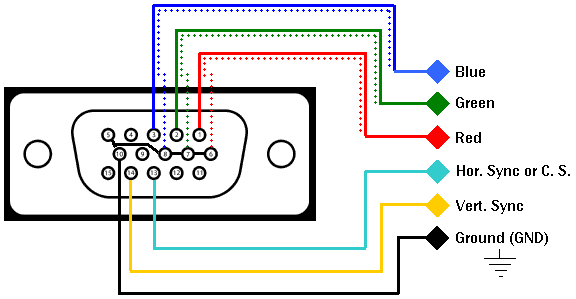
Important: some monitors have switches or jumpers in their boards that must be set according to input signal. It is important to read its technical manual and set the right settings for your needs. There are some settings that often cause problems:
hsync and vsync for horizontal and vertical
sync respectively.If your PC does not sense your monitor it is likely your monitor is not loading the RGB signals. Measure input resistance from one video signal (R, G or B) to ground with an ohmmeter, in 200 ohm scale it should read around 75 ohm. Some monitors have a switch or jumper to enable loading of video signals, if yours does not have this setting you can add three 75 ohm resistors from each video signal to ground as shown below.
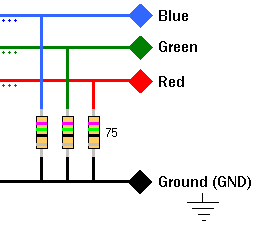
If your monitor accepts only composite syncs, it is not recommended to connect
H and V signals together. If you use an ATI card you can enable composite
sync in ATI control panel or WinModelines. Then connect VGA pin 13 to composite
sync input (do not connect pin 14). If you still experience problems you may have
to change output polarity from ATI control panel or replacing -hsync -vsync
by +hsync +vsync in all modelines within WinModelines.
For non-ATI video cards, if you experience problems connecting H and V syncs together you can generate quality composite sync with this circuit:
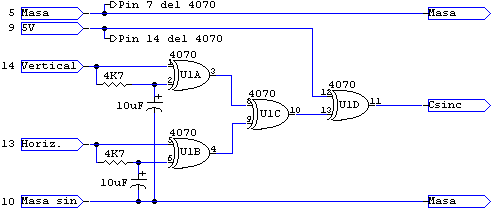
This circuit fixes sync polarities and will always output negative sync (TV compatible). If you still have problems try to change to positive syncs by connecting 4070 pin 12 to ground instead of 5V.
4070 chip is very cheap and easy to find at any electronics store. Each manufacturer has its own prefix so you can find CD4070, HEF4070, MC4070, etc. all of them are the same. It is very important to connect ground to pin 7 and supply 5V to pin 14. You can get 5V from a MOLEX connector, monitor supply or any other 5V supply you have around.
This is the chip pin numbering:
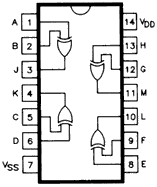
This cable lets you connect PC VGA output to a TV or VCR composite video input. Generated signal is black and white (no colour). You must configure your PC to output the right line and frame refresh rates as explained in the Introduction.
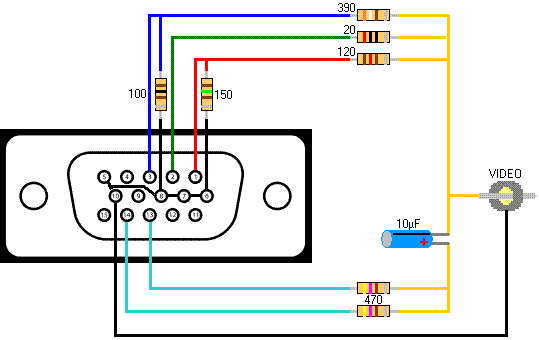
Pay attention to the polarity of electrolytic capacitor, positive must be connected to PC output and negative to video input. It works under very small voltages so any voltage rating will do.
This circuit mixes colours following this ITU specification:
Y = 0,222 Red + 0,707 Green + 0,071 Blue
Red objects show up as dark grays and blue is very dark gray. If you think these grays are too dark you can increase their brightness by removing 100 and 150 ohm resistors or lowering the value of 120 and 390 ohm resistors.
This cable lets you connect an Arcade game board with Jamma interface to a TV scart socket. The scart socket must be RGB capable.
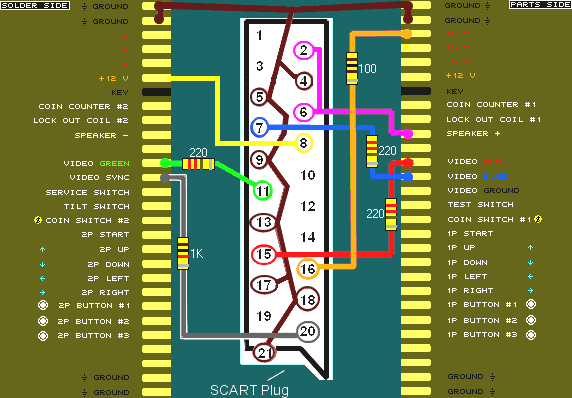
Note: if you use a standard male-male scart cable and a female socket you must change the following pins: 20 → 19, 6 → 3 and 2 → 1. This is because a male-male cable connects inputs to outputs.
A similar drawing is published in some other web sites but observe the version shown here has a modification regarding audio connections. It is recommended to follow this one to avoid damage to the audio amplifier in your game boards.
If audio sounds too strong or distorted, lower the volume setting on your game board. If it provides no volume control or does not have a proper range you can put a volume adjustment adding a 10K preset in the audio wire:

This cable lets you connect a DVD player, DTV receiver or any other device with RGB scart output to an Arcade or PC monitor.
To use a PC monitor you must enable Progressive scan in your set top box, if your device does not have this capability then you cannot use a PC monitor. On the other hand, for an Arcade monitor you do not need this feature and any box that outputs RGB can be connected.
In both cases it is required that your box outputs RGB signals in its Scart socket. Many but not all digital devices do that, and in some cases you must enable RGB output within a settings menu. Note: a VHS VCR or an analogue tuner (satellite / cable / terrestrial) does not offer RGB signals and will not work with this circuit.
Electrical schematic:
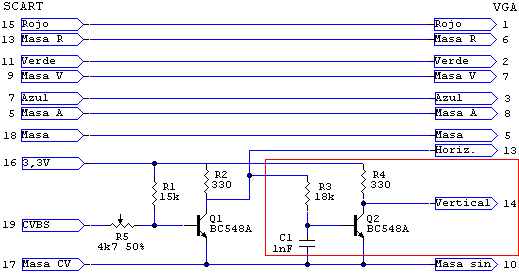
Connection diagram:
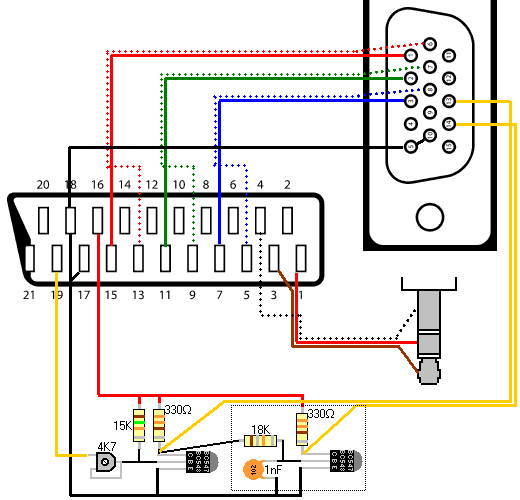
Connector shown at bottom right is a female stereo audio jack to plug amplified PC speakers.
Components surrounded by a dotted line are optional: they generate a vertical sync signal but most monitors do not need it. If your monitor scrolls the picture up or down or does not detect a signal you will have to add these components.
Start by setting the 4K7 preset at middle range. If your monitor does not sync properly, does not detect a signal or displays an Out of range message adjust until it works.
If your Arcade monitor has a switch or jumper to set sync polarities try all settings until it works. This circuit outputs positive H sync and negative V sync.
If it still does not detect a signal or sync properly remove the connection to scart pin 16 and connect that wire to a 5V supply instead, with ground to transistor emitters (E). The scart output may not provide enough voltage or current for proper operation.
Note: if you use a standard male-male scart cable and a female socket you must change the following pins: 20 → 19, 6 → 3 and 2 → 1. This is because a male-male cable connects inputs to outputs.
Project completed on June 2007 by Jeroni Paul.
Copyright © 2007 Jeroni Paul.